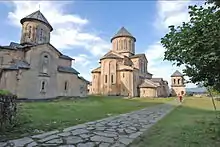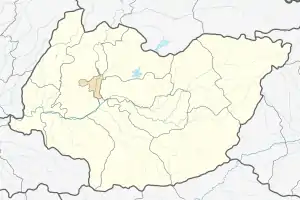Gelati Monastery
Gelati (Georgian: გელათის მონასტერი) is a medieval monastic complex near Kutaisi in the Imereti region of western Georgia. One of the first monasteries in Georgia,[1] it was founded in 1106 by King David IV of Georgia as a monastic and educational center, and is recognized by UNESCO as a World Heritage Site.
| Gelati Monastery | |
|---|---|
გელათის მონასტერი | |
 The monastic complex of Gelati | |
| Religion | |
| Affiliation | Georgian Orthodox Church |
| Region | Caucasus |
| Location | |
| Location | Kutaisi, Imereti, Georgia |
 Shown within Georgia  Gelati Monastery (Imereti) | |
| Geographic coordinates | 42.2945472°N 42.7675583°E |
| Architecture | |
| Type | Monastery |
| Style | Georgian |
| Founder | David IV of Georgia ("David the Builder") |
| Completed | Church of the Virgin, 1106; Churches of St. George and St. Nicholas, 13th century |
| Official name: Gelati Monestary | |
| Criteria | Cultural: iv |
| Reference | 710 |
| Inscription | 1994 (18th session) |
| Endangered | 2010-2017 |
| Area | 4,2 ha |
| Buffer zone | 1,246 ha |
Inside the monastery's church there are murals and imagery dating from the 12th–17th centuries.[2]
The monastery was built in the Georgian Golden Age and a gold aesthetic is employed in the paintings and buildings. It was built to highlight the presence of Christian faith in Georgia.[3] The monastery is covered in arches that stretch over mountains.
Overview
Historically, Gelati was a cultural and intellectual center in Georgia. It had an Academy that employed Georgian scientists, theologians and philosophers, many of whom had previously been active at various Orthodox monasteries abroad, such as the Mangana Monastery in Constantinople. Among its notable scholars were Ioane Petritsi, who translated several classics of philosophy but is best known for his commentaries on Proclus; and Arsen Ikaltoeli, known for his Dogmatikon, or book of teachings, influenced by Aristotle. The Gelati Academy employed scribes to compile manuscript copies of important works,[4] and people of the time called it "a new Hellas" and "a second Athos".[5]
Of all the murals, manuscripts and ikons, perhaps the most valuable was the Khakhuli triptych, enshrined at Gelati until being stolen in 1859. It was returned in 1923, but in a badly reduced condition.[6] Gelati is the burial site of its founder David IV of Georgia. Near King David's grave are the gates of Ganja, which were taken by King Demetrius I of Georgia in 1138.
Landscape
The monastery is located a hill which overlooks Kutaisi, the old capital, a few kilometres to the west. It also overlooks the Tskaltsitela Gorge.
History
The Gelati Monastery was built in 1106 by King David IV of Georgia. It was constructed during the Byzantine Empire, during which Christianity was the ruling religion throughout the empire. The monastery's main church, known as Church of Virgin the Blessed was dedicated to the Virgin Mary. It was also employed to teach science and became an academy of math and sciences in Georgia.
Today
The monastery still oversees Georgia and is a functioning church. Under the supervision of UNESCO the site is being continually restored and protected. All the original structures of the monastery are intact and functional.
The mosaics and murals were damaged prior to UNESCO conservation,[7] but halted when the roof of the academy building was replaced by Georgian conservators.[4] By presidential decree, the monastery was added to the National Register of Monuments for protection and restoration in 2006.
Triptychs
Triptychs were popular during the Byzantine Empire and important in Georgian culture.[8] The triptychs represented another form of contribution to the church. Triptychs were a form of iconography for the congregation.
Mosaics
The interiors of the monastery hold mosaics in classic Byzantine style illustrating aspects of Christian belief. The largest, a 12th-century masterpiece depicting the Virgin Mary holding the baby Jesus, dominates the apse of the main church, and is an artwork of cultural importance in Georgia.[9] Above the altar is situated a statue of the Virgin Mary, looking down at the baby Jesus she is holding.
Architecture
The Gelati monastery is constructed of solid stone, with full archways. The plan of the main monastery was designed in the shape of a cross, the symbol of Jesus's crucifixion and of Christianity.[10] The monastery was designed to be visible over much of the country, with its stone walls constructed to reflect sunlight. There are archways throughout the monastery, including the bell tower.
Burials
Gallery
 Mother of God, mosaic fresco
Mother of God, mosaic fresco Archangel Michael, mosaic fresco
Archangel Michael, mosaic fresco The Ascension, mural (16th century)
The Ascension, mural (16th century) David IV of Georgia, mural
David IV of Georgia, mural.jpg.webp)
 Gelati monastery, church of Virgin Mary the Blessed. Mural of Christ Pantokrator on ceiling of the central dome (12th century)
Gelati monastery, church of Virgin Mary the Blessed. Mural of Christ Pantokrator on ceiling of the central dome (12th century)
 Gelati monastery, Church of Virgin the Blessed. Mural on north wall. From left to right: Queen Rusudan, Prince Bagrat, King George II, Queen Helen, King Bagrat III of Imereti, Catholicos Yevdemon Chetidze, David the Builder
Gelati monastery, Church of Virgin the Blessed. Mural on north wall. From left to right: Queen Rusudan, Prince Bagrat, King George II, Queen Helen, King Bagrat III of Imereti, Catholicos Yevdemon Chetidze, David the Builder Gelati monastery. Church of Virgin the Blessed. Mural.
Gelati monastery. Church of Virgin the Blessed. Mural..PNG.webp) Shrine in the monastery church
Shrine in the monastery church Gelati Monastery
Gelati Monastery.jpg.webp) Gelati Monastery
Gelati Monastery.jpg.webp) Gelati Monastery
Gelati Monastery Gelati Monastery
Gelati Monastery Gelati Monastery
Gelati Monastery Gelati Monastery
Gelati Monastery.jpg.webp) St. George church
St. George church.jpg.webp) St. Nicholas church
St. Nicholas church.jpg.webp) Belfry
Belfry.jpg.webp) Cathedral of the Nativity of the Virgin
Cathedral of the Nativity of the Virgin.jpg.webp) Portal in the cathedral
Portal in the cathedral.jpg.webp) Frescoes in the cathedral
Frescoes in the cathedral.jpg.webp) Frescoes in the cathedral
Frescoes in the cathedral Gelati Monastery
Gelati Monastery
References
- Kaufhold, Hubert (2011). [<http://dx.doi.org.ezproxy2.library.usyd.edu.au/10.1163/1877-5888_rpp_SIM_08287> "Gelati Monastery"] Check
|url=value (help). Religion Past and Present. doi:10.1163/1877-5888_rpp_SIM_08287. - "World Heritage Site". 1997–2020.
- Calma, Dragos (2020). Reading Proclus and the Book of Causes, Volume 2. Dublin: University College Dublin.
- "Gelati Monastery". UNESCO. Retrieved 24 November 2020.
- Chatzidakis, Nano. Byzantine Mosaics, Volume 7. Athens, Greece: Ekdotike Athenon, 1994, p.22
- Eastmond, Antony (2001), Eastern approaches to Byzantium: papers from the Thirty-third Spring Symposium of Byzantine Studies, University of Warwick, Coventry, March 1999, pp. 216-217. Ashgate/Variorum, ISBN 0-7546-0322-9, ISBN 978-0-7546-0322-1
- Riggs, Thomas (2015). Worldmark Encyclopedia of Religious Practices. 2nd ed., vol. 2: Countries, Afghanistan to Ghana. Farmington Hills: Gale.
- Dzhindzhikhashvili, Zoia (1996). ncyclopedia of World Cultures, vol. 6: Russia and Eurasia/China. NY: Macmillan Reference USA.
- Most, W.G (2003). "Canon, Biblical". New Catholic Encyclopedia. 3: 20–34.
- McClymond, Michael (2015). "Christianity". Worldmark Encyclopedia of Religious Practices. 1: 119–168.
- Byzantine Art, www.bourgogneromane.com/Byzantine.htm.
- Centre, UNESCO World Heritage. “Gelati Monastery.” UNESCO World Heritage Centre, whc.unesco.org/en/list/710.
- Chichinadze, Nina. “Some Compositional Characteristics of Georgian Triptychs of the Thirteenth through Fifteenth Centuries.” Gesta, vol. 35, no. 1, 1996, pp. 66–76. JSTOR, JSTOR, www.jstor.org/stable/767227.
- Derlemenko I︠E︡vhen Anatoliĭovych, and Gigilashvili Ėduard. Gelati : Arkhitektura, Mozaika, Freski (Fotoalʹbom]= Gelati : Architecture, Mosaic, Frescoes. Tbilisi, Khelovneba, 1982.
- Hubert Kaufhold, Brill. Georgian Monasteries.
- Mepʻisašvili, R. Gelati. "Sabčotʻa Sakʻartʻvelo", 1965.
External links
Adapted from the Wikinfo article Gelati Monastery by Levan Urushadze, licensed under the GNU Free Documentation License.
| Wikimedia Commons has media related to Gelati Monastery. |